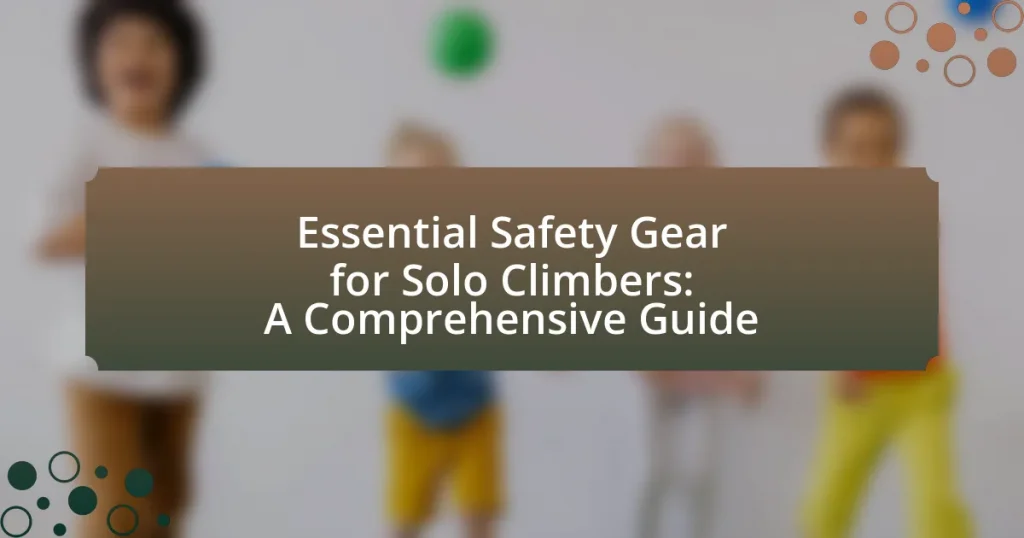Essential Safety Gear for Solo Climbers is a comprehensive guide that outlines the critical equipment necessary for safe climbing without a partner. Key safety gear includes harnesses, climbing ropes, carabiners, belay devices, helmets, and specialized footwear, each serving a specific function to minimize risks associated with solo climbing. The article emphasizes the importance of using appropriate safety gear to mitigate the dangers of falls, lack of immediate assistance, and psychological stress. Additionally, it discusses best practices for gear maintenance, selection, and the common mistakes climbers make, providing essential insights for enhancing safety during solo climbing activities.

What is Essential Safety Gear for Solo Climbers?
Essential safety gear for solo climbers includes a harness, climbing rope, carabiners, belay device, helmet, and appropriate footwear. The harness secures the climber to the rope, while the climbing rope provides a lifeline in case of a fall. Carabiners are essential for connecting gear and securing the rope, and a belay device is crucial for managing rope tension and braking during descents. A helmet protects against falling debris and impacts, and specialized climbing shoes enhance grip and stability on various surfaces. These items are fundamental for ensuring safety and minimizing risks associated with solo climbing.
Why is safety gear crucial for solo climbing?
Safety gear is crucial for solo climbing because it significantly reduces the risk of injury or fatality in the event of a fall or accident. In solo climbing, the absence of a partner means that climbers must rely entirely on their equipment for safety. For instance, harnesses, ropes, and protective gear like helmets and crash pads are designed to absorb impact and prevent serious injuries. Statistics indicate that falls are a leading cause of climbing accidents, and using appropriate safety gear can mitigate these risks. Research shows that climbers who utilize safety equipment are less likely to sustain severe injuries compared to those who do not. Therefore, the implementation of safety gear is essential for ensuring the climber’s protection and enhancing overall climbing safety.
What are the risks associated with solo climbing?
The risks associated with solo climbing include falls, lack of immediate assistance, and increased psychological stress. Falls can occur due to equipment failure or misjudgment, leading to severe injuries or fatalities; statistics indicate that solo climbers face a higher fatality rate compared to those who climb with partners. The absence of immediate assistance means that in the event of an accident, a solo climber may not receive timely help, which can exacerbate injuries or lead to life-threatening situations. Additionally, the psychological stress of climbing alone can impair decision-making and increase the likelihood of errors, as climbers may experience anxiety or fatigue without the support of a partner.
How does safety gear mitigate these risks?
Safety gear mitigates risks for solo climbers by providing essential protection against falls, injuries, and environmental hazards. For instance, harnesses secure climbers to ropes, reducing the likelihood of fatal falls, while helmets protect against head injuries from falling rocks or equipment. Additionally, climbing shoes enhance grip and stability, minimizing slips that could lead to accidents. According to the American Alpine Club, proper use of safety gear can significantly decrease the incidence of climbing-related injuries, demonstrating its critical role in ensuring climber safety.
What types of safety gear are essential for solo climbers?
Essential safety gear for solo climbers includes a harness, climbing rope, carabiners, belay device, helmet, and a first aid kit. The harness secures the climber to the rope, while the climbing rope provides the necessary support during ascents and descents. Carabiners are crucial for connecting various components, and a belay device aids in managing the rope’s tension. A helmet protects against falling debris, and a first aid kit ensures preparedness for injuries. These items are fundamental for minimizing risks associated with solo climbing, as they enhance safety and increase the likelihood of a successful climb.
What are the key components of climbing harnesses?
The key components of climbing harnesses include the waistbelt, leg loops, gear loops, and a belay loop. The waistbelt provides support and distributes weight around the climber’s torso, while the leg loops secure the harness around the thighs for stability. Gear loops are attached to the harness for carrying climbing equipment, and the belay loop is a reinforced section designed for attaching the climbing rope during belaying. These components are essential for safety and functionality, as they ensure proper weight distribution and secure attachment points for climbing gear.
How do climbing ropes differ in safety features?
Climbing ropes differ in safety features primarily through their construction, type, and intended use. Dynamic ropes, designed to stretch under load, absorb the energy of a fall, reducing the impact force on the climber and gear, while static ropes, which have minimal stretch, are used for rappelling and rescue operations where energy absorption is less critical. Additionally, climbing ropes are rated for different types of falls, with UIAA (International Climbing and Mountaineering Federation) testing standards ensuring that ropes meet specific safety criteria, such as impact force and number of falls survived. For instance, a dynamic rope typically has a maximum impact force rating of around 8-10 kN, which is crucial for protecting climbers during falls.
What role do carabiners play in climbing safety?
Carabiners are crucial components in climbing safety as they connect various elements of climbing gear, such as ropes, harnesses, and protection devices. Their primary function is to create secure attachment points that can withstand significant forces during falls, thereby preventing accidents. For instance, a standard locking carabiner can hold a minimum of 20 kN (kilonewtons) of force, which is essential for ensuring the climber’s safety in case of a slip or fall. Additionally, carabiners facilitate quick and efficient gear management, allowing climbers to easily clip and unclip equipment while maintaining safety.
Why are helmets important for solo climbers?
Helmets are crucial for solo climbers because they provide essential protection against head injuries from falling rocks or accidental falls. In climbing environments, loose debris can pose significant risks, and a helmet can absorb impact forces, reducing the likelihood of severe injury. Studies indicate that head injuries account for a substantial percentage of climbing-related accidents, emphasizing the importance of wearing a helmet to mitigate these risks.
How can solo climbers choose the right safety gear?
Solo climbers can choose the right safety gear by assessing their climbing environment, understanding their personal skill level, and selecting equipment that meets safety standards. Evaluating the climbing environment involves considering factors such as rock type, weather conditions, and route difficulty, which directly influence the type of gear needed. For instance, a climber tackling mixed terrain may require a combination of traditional protection and sport climbing gear.
Understanding personal skill level is crucial; beginners may prioritize harnesses with additional safety features, while experienced climbers might opt for lighter, more technical gear. Selecting equipment that meets safety standards, such as those set by the American National Standards Institute (ANSI) or the International Climbing and Mountaineering Federation (UIAA), ensures reliability and safety during climbs.
Research indicates that using gear that is specifically designed for solo climbing, such as auto-locking belay devices and personal anchors, significantly reduces the risk of accidents. Therefore, solo climbers should focus on gear that is appropriate for their specific climbing scenarios, skill levels, and adheres to recognized safety standards.
What factors should be considered when selecting climbing gear?
When selecting climbing gear, climbers should consider safety, durability, weight, and suitability for the specific climbing type. Safety is paramount; gear must meet industry standards, such as those set by the UIAA or CE, ensuring it can withstand the forces encountered during a fall. Durability is essential as climbing gear is subjected to harsh conditions; materials like nylon and dyneema are commonly used for their strength and resistance to abrasion. Weight impacts performance, especially in multi-pitch climbs or long routes, where lighter gear can reduce fatigue. Finally, suitability involves choosing gear designed for the specific climbing discipline, such as sport, trad, or alpine climbing, as each has unique requirements.
How do personal preferences influence gear selection?
Personal preferences significantly influence gear selection by determining the specific features and functionalities that climbers prioritize in their equipment. For instance, a climber who values lightweight gear may choose ultralight harnesses and carabiners, while another who prioritizes durability might opt for heavier, more robust options. Research indicates that individual experiences, comfort levels, and aesthetic choices also play critical roles in this decision-making process, as climbers often select gear that aligns with their personal style and past experiences in the field. This alignment between personal preferences and gear selection ultimately affects performance, safety, and overall climbing enjoyment.

What are the best practices for using safety gear in solo climbing?
The best practices for using safety gear in solo climbing include thorough equipment checks, proper usage of harnesses and anchors, and understanding fall factors. Climbers should inspect all gear, including ropes, carabiners, and harnesses, for wear and damage before each climb. Properly securing the harness and ensuring that anchors are placed correctly and tested for stability are crucial to prevent accidents. Additionally, climbers must be aware of the fall factor, which is the ratio of the distance fallen to the length of rope available to absorb the fall; minimizing this factor reduces the risk of injury. These practices are supported by climbing safety guidelines from organizations such as the American Alpine Club, which emphasize the importance of equipment integrity and proper technique in solo climbing scenarios.
How should safety gear be maintained for optimal performance?
Safety gear should be maintained by regularly inspecting, cleaning, and properly storing it to ensure optimal performance. Regular inspections should include checking for signs of wear, damage, or degradation, as even minor issues can compromise safety. Cleaning should be done according to the manufacturer’s guidelines, using appropriate methods to avoid damaging materials; for example, harnesses and ropes should be washed with mild soap and air-dried away from direct sunlight. Proper storage involves keeping safety gear in a cool, dry place, away from direct sunlight and chemicals, which can degrade materials over time. Following these maintenance practices helps ensure that safety gear remains reliable and effective during use.
What are the signs of wear and tear in climbing gear?
Signs of wear and tear in climbing gear include frayed ropes, worn harnesses, and damaged carabiners. Frayed ropes exhibit visible strands that compromise their strength, while worn harnesses may show signs of fading or cracking in the webbing, indicating reduced safety. Damaged carabiners can have bent gates or visible scratches that affect their locking mechanism. Regular inspection of these components is crucial, as the International Climbing and Mountaineering Federation recommends replacing gear that shows significant wear to ensure climber safety.
How often should safety gear be inspected and replaced?
Safety gear should be inspected before each use and replaced according to the manufacturer’s guidelines, typically every 1 to 5 years depending on the type of gear and frequency of use. Regular inspections help identify wear and tear, while replacement ensures optimal safety performance. For instance, climbing harnesses and ropes often have specific lifespan recommendations; ropes may need replacement after 3 to 5 years, while harnesses can last up to 10 years if properly maintained. Following these guidelines is crucial for ensuring safety during climbing activities.
What techniques can enhance safety while climbing solo?
Techniques that can enhance safety while climbing solo include thorough route planning, using appropriate safety gear, and maintaining constant communication. Thorough route planning involves studying the climbing route, assessing potential hazards, and understanding weather conditions, which can significantly reduce risks. Utilizing appropriate safety gear, such as harnesses, ropes, and belay devices, ensures that climbers are secured and can manage falls effectively. Maintaining constant communication, whether through a mobile device or a pre-established check-in system, allows for timely assistance in case of emergencies. These techniques are supported by climbing safety guidelines from organizations like the American Alpine Club, which emphasize preparation and risk management as key components of safe solo climbing.
How can climbers effectively plan their routes?
Climbers can effectively plan their routes by conducting thorough research on the climbing area, assessing the difficulty of the routes, and utilizing topographic maps and climbing guides. This approach ensures climbers understand the terrain, potential hazards, and the required skills for each route. For instance, the American Alpine Club emphasizes the importance of route selection based on climber experience and environmental conditions, which can significantly impact safety and success. Additionally, climbers should consider weather forecasts and local climbing regulations to avoid dangerous situations and ensure compliance with safety standards.
What are the best practices for setting up anchors?
The best practices for setting up anchors include selecting strong, reliable points, using appropriate gear, and ensuring redundancy. Strong anchor points should be solid rock or well-placed bolts, as they provide the necessary support for climbers. Using gear such as slings, carabiners, and quickdraws that are rated for climbing ensures safety and reliability. Redundancy is crucial; setting up multiple anchors or using a backup system minimizes the risk of failure. According to the American Alpine Club, proper anchor setup is vital for preventing accidents and ensuring climber safety.

What common mistakes do solo climbers make regarding safety gear?
Solo climbers commonly make mistakes such as neglecting to use a harness, failing to check gear compatibility, and not carrying sufficient backup equipment. Neglecting to wear a harness can lead to severe injuries in case of a fall, as it is essential for securing the climber to the rope. Additionally, failing to check gear compatibility, such as mismatching carabiners and ropes, can result in equipment failure; for instance, using a non-locking carabiner in critical situations can lead to accidental disengagement. Lastly, not carrying sufficient backup equipment, like extra slings or a second rope, increases risk during emergencies, as statistics show that many accidents occur due to equipment failure or unexpected situations.
What are the pitfalls of using outdated or damaged gear?
Using outdated or damaged gear significantly increases the risk of accidents and injuries in climbing. Outdated gear may not meet current safety standards, leading to potential failures during critical moments, while damaged gear can compromise structural integrity, resulting in catastrophic failures. For instance, a study by the American Alpine Club highlights that 70% of climbing accidents are attributed to equipment failure, emphasizing the importance of using reliable and up-to-date gear. Additionally, outdated gear may lack advancements in technology that enhance safety and performance, further increasing the likelihood of mishaps.
How can climbers avoid over-reliance on specific gear?
Climbers can avoid over-reliance on specific gear by diversifying their equipment choices and regularly practicing with various tools. This approach ensures that climbers develop a broader skill set and adaptability in different climbing scenarios. For instance, using a mix of protection types, such as cams, nuts, and quickdraws, allows climbers to become proficient in placing and using each type effectively. Additionally, engaging in training sessions that focus on traditional climbing techniques can enhance a climber’s ability to navigate without depending solely on modern gear. Studies show that climbers who practice with a variety of gear report increased confidence and improved problem-solving skills in challenging situations.
What tips can improve safety for solo climbers?
To improve safety for solo climbers, it is essential to conduct thorough route planning and risk assessment before the climb. This involves studying the terrain, weather conditions, and potential hazards, which can significantly reduce the likelihood of accidents. Research indicates that climbers who prepare adequately are less likely to encounter dangerous situations, as they can anticipate challenges and make informed decisions. Additionally, using appropriate safety gear, such as a harness, helmet, and climbing rope, further enhances safety by providing necessary protection against falls and injuries.
How can climbers develop a safety checklist before climbing?
Climbers can develop a safety checklist before climbing by systematically identifying essential gear and safety protocols tailored to their specific climbing environment. This process involves assessing the type of climb, weather conditions, and personal experience level to ensure all necessary equipment is included, such as harnesses, ropes, carabiners, helmets, and first aid kits. Additionally, climbers should incorporate safety practices like checking knots, verifying gear integrity, and establishing communication plans. Research indicates that structured checklists significantly reduce accidents in outdoor activities, highlighting the importance of thorough preparation in climbing safety.
What resources are available for learning about climbing safety gear?
Resources for learning about climbing safety gear include instructional books, online courses, and reputable climbing organizations. Books such as “Mountaineering: The Freedom of the Hills” provide comprehensive information on safety gear and its proper use. Online platforms like Coursera and Udemy offer courses specifically focused on climbing safety, including gear selection and usage. Additionally, organizations like the American Alpine Club and the International Climbing and Mountaineering Federation provide guidelines, articles, and workshops that emphasize safety gear education. These resources are validated by their widespread use in climbing communities and endorsements from experienced climbers and instructors.
